Healing Kitchari
Recipe Key
Kitchari is a traditional Ayurvedic recipe that is gentle on digestion, made with mung dal, basmati rice and warming spices. This one pan meal is comforting, nourishing, and incredibly healing. It’s a delicious make-ahead-meal with lots of vegetables you can enjoy any time of the day.
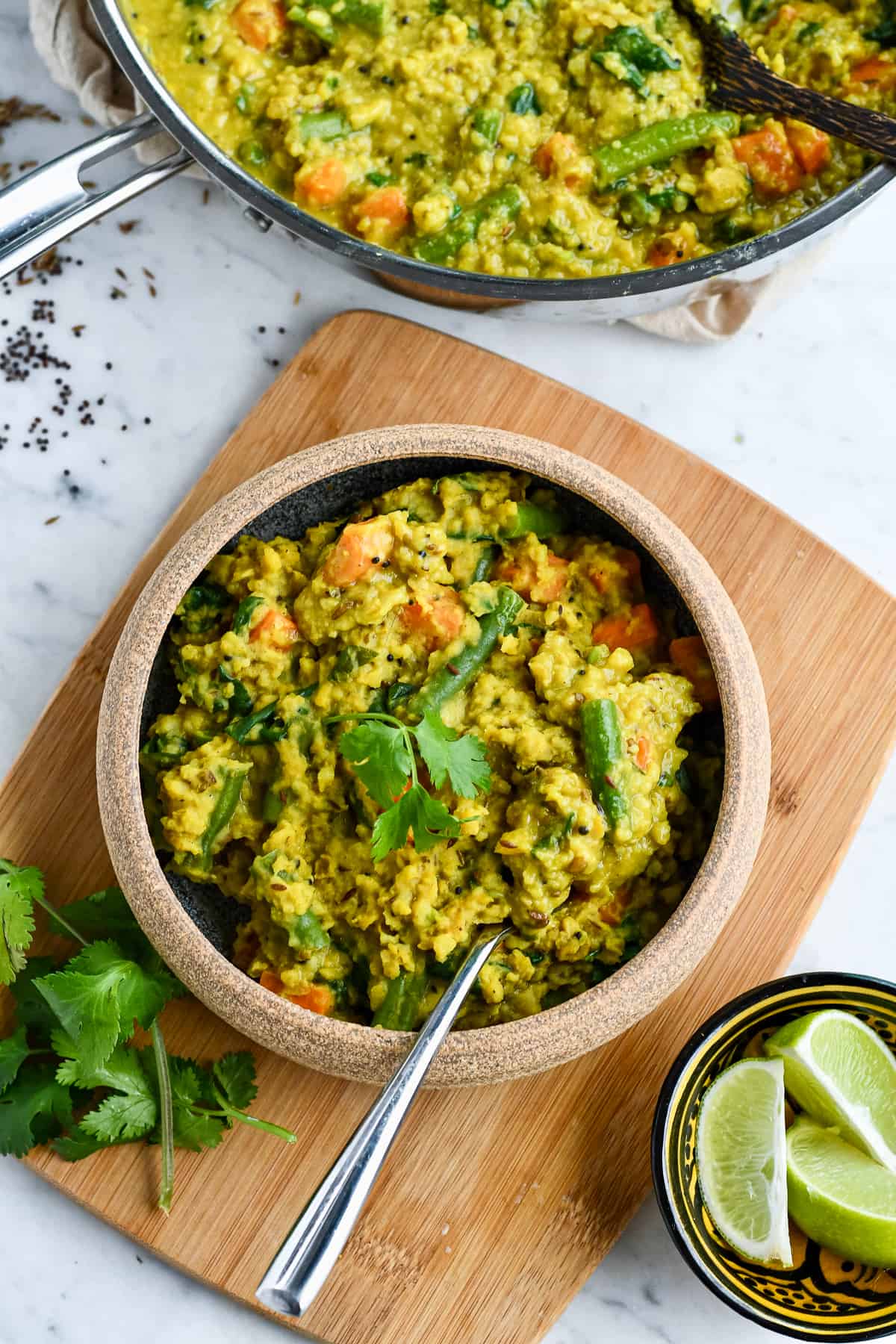
After eating a strictly paleo diet for many years I have started eating Kitchari to strengthen my digestion. I am eating it regularly because it tastes great and feels so good in my body. Adding kitchari to my diet helps me to digest more varieties of food.
What is Kitchari
Kitchari, pronounced kich-ah-ree means mixture. It’s a is blend of basmati rice and split yellow mung beans, spiced with ginger, turmeric and other spices.
Kitchari is Ayurveda’s most medicinal food used to purify digestion and cleanse systemic toxins. What makes it special is it’s very easy to digest and it heals and soothes the intestinal wall.
In India it is often babies first food, given to the elderly and the sick, along with healthy adults during special times of detox, cleansing, and spiritual practice. I learned about it from my Ayurvedic doctor, Dr John Douillard.
You can make it thin like a rice cereal or thick and creamy like risotto. I like it thicker. You can eat it for one meal or use it as a cleanse for a few days. I add vegetables to make the kitchari recipe more of a complete meal.
Why Is Kitchari Healing For Your Digestive System
Kitchari is satiating, easy to digest, and is also jam-packed with plenty of nutrients needed for healing.
Even though one of the main ingredients in Kitchari is a legume, this dish is actually easy to digest. According to Ayurveda, split mung beans are the only bean classified as anti-vata or anti-gas. This means that unlike every other type of beans or lentils they will not produce intestinal gas.
White rice is used because the hull is removed and it’s easier to digest than brown rice. While brown rice can be used, it is harder to digest and can irritate the intestinal wall.
Kitchari provides nourishment in the form of all the amino acids needed to keep blood sugars stable.
Ingredients Benefits and Substitutions
Mung Dal also known as split yellow mung beans. Red lentils can be used in a pinch. Mung dhal is available in Indian Grocery stores or order online. Soak your mung dhal overnight to make it more digestible.
White Basmati Rice – Long-grain white rice is typically used because it is more nutritious than short-grain. Even without the husk, it is considered more blood sugar stable. Studies have shown long-grain white rice is a low glycemic index food, lower than short-grain and other forms of rice. (1) Quinoa can be substituted.
Ghee or Coconut Oil – Traditionally ghee is used but if you’re vegan coconut oil is a good choice.
Fresh Ginger Root is highly beneficial to the digestive system.
Kitchari Spices – Both ground and whole spices are used to enhance flavor and for detoxifying and anti-inflammatory properties. I use mustard seeds, cumin seeds, fennel seeds, turmeric, ground cumin, ground coriander, black pepper, bay leaf and ground cloves. There are many different recipes with regard to spices. They can be modified as you like. Read more about spices in Kitchari here.
Water or Broth – to keep your kitchari authentic make sure your broth does not contain onions or garlic which remove some of the Ayurvedic properties. I like homemade chicken bone broth or vegetable broth for extra taste and nutrients but water is traditionally used.
Vegetables – Use whatever vegetables you like and cut them into small pieces. I typically use a mix of seasonal vegetables and almost always use carrots. In this recipe I use string beans, carrots and spinach. You can use fresh or frozen veggies.
Cilantro is a chelating agent naturally cleansing the body of harmful toxins. Top your kitchari with it for taste and health benefits

How To Make Kitchari
Soak the mung dal for easy digestion.
The first step is to assemble your spices. In one small bowl mix together the whole seeds; cumin, fennel and black mustard seeds. In a second bowl mix the ground spices; turmeric, cumin, coriander, black pepper and cloves. Have the bay leaf nearby.
In a deep skillet toast the whole cumin seeds, mustard seeds and fennel seeds in ghee or coconout oil to infuse the oil with flavor and give the seeds more nuttiness.
Next add ginger and the ground spices. Stir for a few seconds and immediately add the rice and mung dal so you don’t burn the spices.
Add the water or broth. Bring to a boil, lower the heat, cover and simmer for 30 minutes. Stir occasionally.
Add carrots and string beans (any firm vegetables) and additional water or broth if the kitchari is thick. I usually add an additional cup to get a risotto-like consistency, soft and creamy. Leave it out if you want it thicker. Simmer 10 minutes more or until vegetables are tender.
Add spinach (any leafy vegetable), stir and cook 1-2 minutes until wilted.
Add salt and stir. Serve topped with cilantro and a squeeze of lime juice.
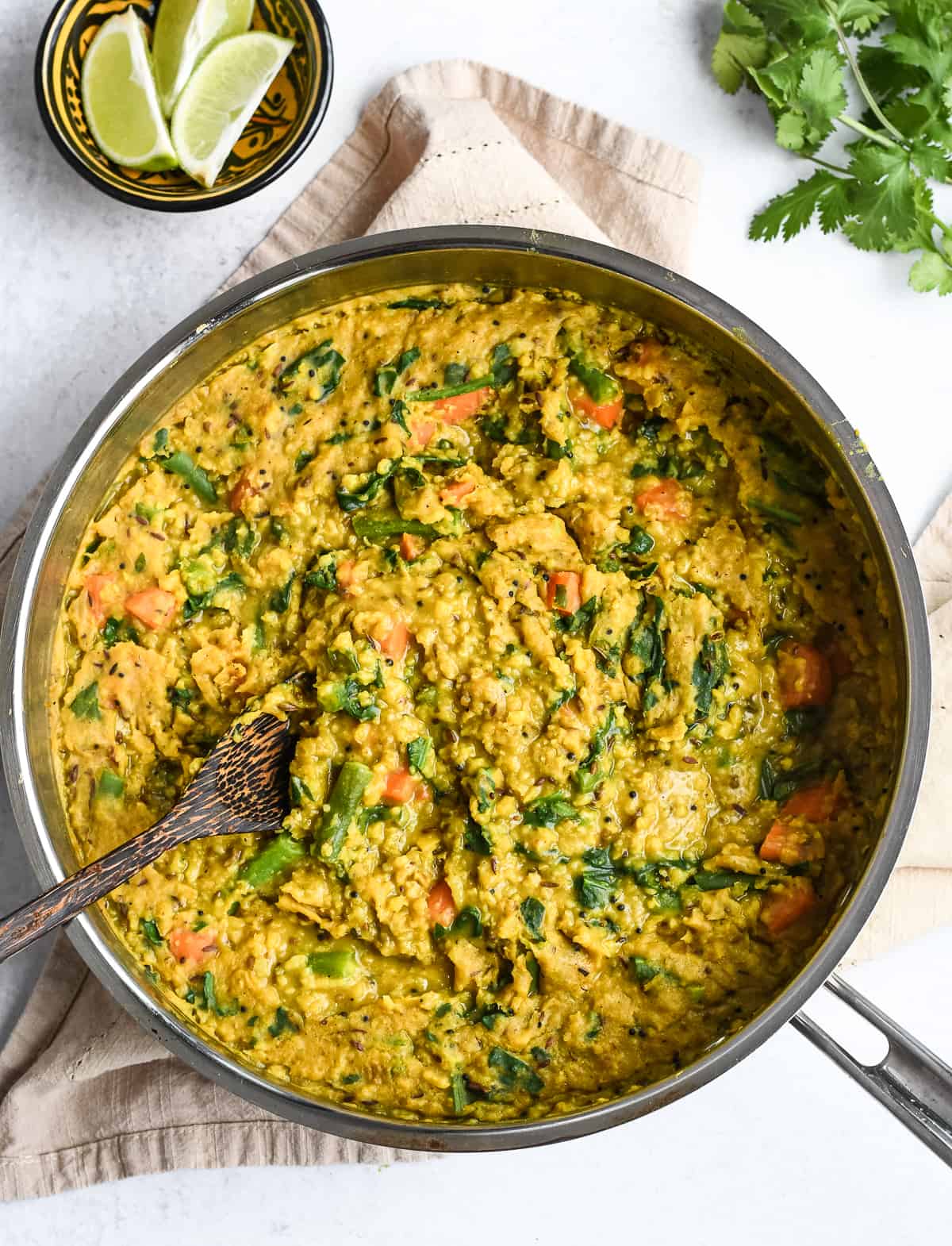
Storing Kitchari
Kitchari is great a great make-ahead-meal because it reheats well.
You can make a double recipe and keep it in the fridge for days. Just heat it up whenever you’re ready to eat it! Reheat on the stovetop, stirring frequently, until warmed (add more water or broth as needed if dry).
To freeze: Store in a freezer-safe container for up 1 month. Be sure to thaw before reheating it.
Kitchari can be enjoyed at any time of day, I like it for breakfast but it’s most often enjoyed for lunch or dinner as a main dish.
Enjoy this deliciously creamy, comforting, flavorful, healing dish.
⭐️ RATE THE RECIPE!
Your feedback is valuable 💛 it helps me fine-tune the recipes and ultimately make them more successful. Please leave your comments and ratings below, sharing any suggestions or adaptions for other readers. Have questions? I personally respond within 24 hours. Thanks, this is the BEST way to show your support.
If you like this recipe, try these other Indian inspired meals:
Indian Vegetables with Coconut Lentils
Curried Cauliflower Soup with Spinach
Would you like to have more of these delicious healthy recipes sent to you each week? CLICK TO SIGN UP for my weekly email newsletter of recipes and tips for you to eat well and enjoy your wonderful life.
Note: This post contains Amazon affiliate links. This means that if you click on a link and make a purchase, I will receive a small commission at no cost to you. As an Amazon Associate, I earn from qualifying purchases. Thank you for supporting Eat Well Enjoy Life.
PrintKitchari
Kitchari is traditional Ayurvedic recipe made with mung dal, basmati rice and spices. In this recipe we add vegetables to make it a complete meal. It’s best to soak the mung beans ovenight so plan ahead.
- Prep Time: 10
- Cook Time: 1 hour
- Total Time: 1 hour 10 minutes
- Yield: 4 servings 1x
- Category: Main Dish,
- Method: Simmer
- Cuisine: Vegan, Gluten-Free, Dairy Free
Ingredients
- 1/2 cup Mung dal (split yellow mung beans)
- 1/4 cup white basmati rice
- 1 Tablespoon ghee or coconut oil
- 1 teaspoon black mustard seeds
- 1 teaspoon whole fennel seeds
- 1 teaspoon whole cumin
- 1 teaspoon ground cumin
- 1 teaspoon turmeric
- 1/2 teaspoon ground coriander
- 1/4 teaspoon ground black pepper
- 1/8 teaspoon ground cloves or 1 whole clove
- 1 bay leaf
- 1 Tablespoon fresh ginger root, minced
- 4 – 5 cups broth or water
- 2 1/2 cups chopped vegetables of choice ( 3/4 cup string beans, 3/4 cup carrots, 1 cup spinach)
- 1/2– 1 teaspoon Celtic sea salt
- Cilantro for serving
- Lime juice for serving
Instructions
- SOAK MUNG DAL: Add mung dal to a mixing bowl and cover with water by at least 2 inches. It will expand as it soaks. Soak for 12-24 hours, then drain and set aside.
- Wash the rice until water runs clear.
- In a small bowl, mix the mustard, cumin and fennel seed.
- Measure the ground cumin, turmeric, coriander, black pepper and cloves and put into a separate bowl.
- Mince the ginger. Have the bay leaf on hand.
- Heat ghee in large deep skillet on medium-low, add mustard seeds, cumin seeds and fennel seeds. Sauté until you hear the seeds pop, 1-2 minutes.
- Quickly add the ground spices and ginger. Stir. Immediately add the rice and mung dal so you don’t burn the spices. Stir to coat the rice and mung dal with the spices.
- Add 4 cups broth or water and bay leaf. Bring to a boil.
- Turn heat to low, cover pot and continue to cook until dal and rice become soft and porridge like (about 30 minutes), stirring occasionally.
- Add vegetables (except spinach) and more broth to get a risotto like consistency (about 1 cup).
- Simmer 5-10 minutes until vegetables are tender. Add spinach. Simmer 1-2 minutes until wilted.
- Add salt to taste.
- Serve garnished with fresh cilantro and lime juice.
Notes
Nutrition information is with water.

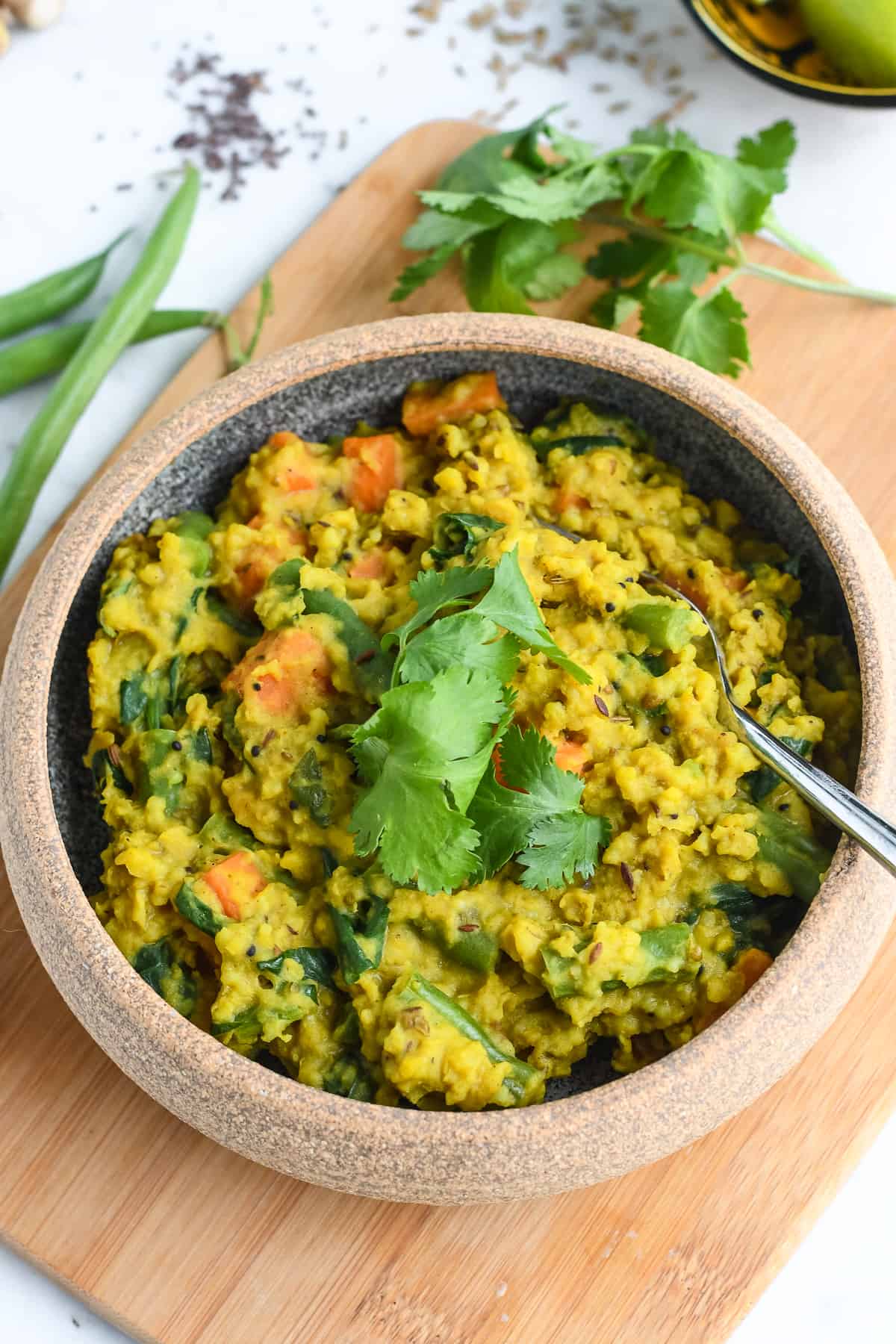
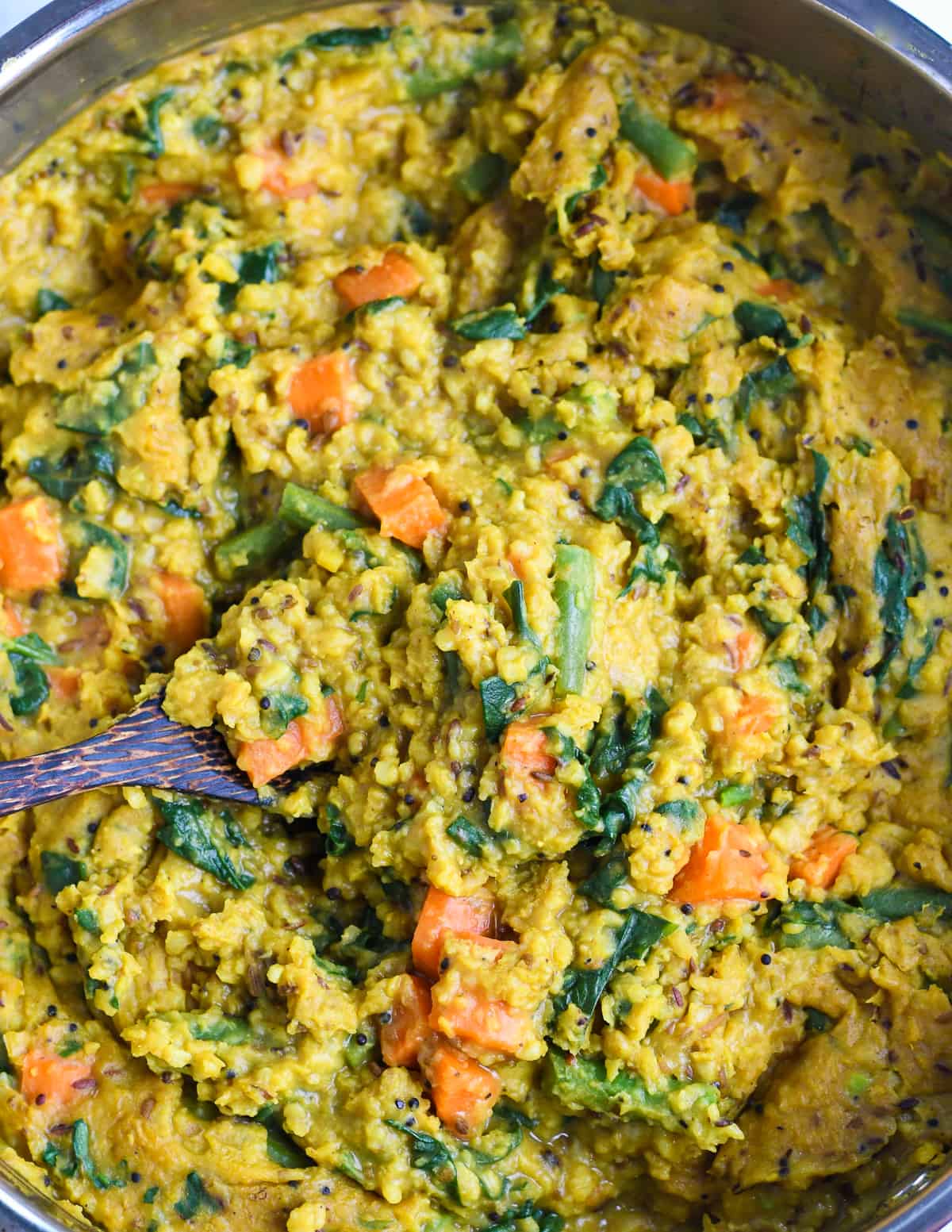

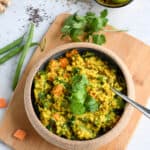
Love this filling nutritious recipe!
Thanks Janice, it’s so healing and tastes great. Perfect for cleansing after the holiday!